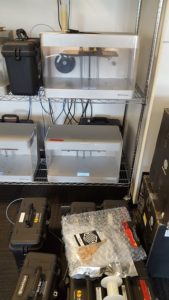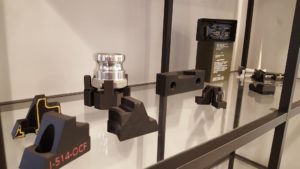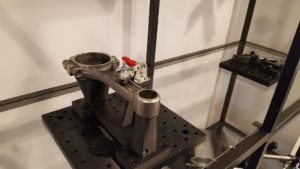 Boston, Massachusetts is coming into its own as a hub of advanced technologies, championed by an expanding array of strong businesses and fed into through a wealth of prestigious local institutions of higher education. 3D printing is, unsurprisingly, thriving in such an environment, and strongly featuring in this picture is high-strength 3D printing company Markforged, founded in 2013 by CEO Greg Mark. I recently enjoyed the opportunity to visit Mark and several members of the team at the company’s headquarters in Watertown to discuss technology on their turf rather than at 3D printing shows around the country.
Boston, Massachusetts is coming into its own as a hub of advanced technologies, championed by an expanding array of strong businesses and fed into through a wealth of prestigious local institutions of higher education. 3D printing is, unsurprisingly, thriving in such an environment, and strongly featuring in this picture is high-strength 3D printing company Markforged, founded in 2013 by CEO Greg Mark. I recently enjoyed the opportunity to visit Mark and several members of the team at the company’s headquarters in Watertown to discuss technology on their turf rather than at 3D printing shows around the country.
The Watertown facility is new to Markforged — my visit was, in fact, just three days after the team moved into the 43,000-square-foot space. The move was necessary, as the young company has been growing quickly with some impressive recent upticks in business. Markforged, now 85 employees strong, outgrew its former 16,000-square-foot HQ in Cambridge, and is already working to fill the new capacity, with the team expected to expand beyond 100 members by the end of the year. The growth in space and personnel is supported by some serious business increases, as Markforged reports more than 300% growth since the start of 2017, which they note as being more than any previous year in the history of the company. Strong sales led to achieving profitability in the first half of 2017.
Mark credits his team with the positive momentum, and noted that the new space allows for easier connections with everyone in the company, including those working around the globe through digital connections.
“One of the reasons we’re growing so fast is that 300% year-over-year growth, done in a profitable way,” Jason Eubanks, Chief Revenue Officer said — as Mark interjected that that was “awesome, by the way.” He noted as well that Eubanks was brought into the team to scale up operations, an area where he has significant experience.
Eubanks continued, “We’re doubling our printer placements every year. We have shipped thousands all over the world.”
For concrete examples, the team pointed to several customer stories. Successes and experiences from real-world users allow Markforged to show, rather than tell, the viability of their 3D printers and high-strength materials in a variety of industries. Mark, Eubanks, Vice President of Marketing Cynthia Gumbert, and Communications Manager Kerry Murphy walked me through just a quick few field users who have shared their stories of using Markforged technology.
“Engineers are inherently risk-averse; they’re trained to be,” Eubanks commented. “If they see someone who looks like them, they are better able to make a case for their boss to say yes to bringing in new technology.”
Dixon Valve, a century-old business in Maryland, has been using technology from Markforged for some time now, expressing interest in adding to their holdings with the recently expanded industrial series of high-strength Continuous Carbon Fiber (CCF) 3D printers. While now bringing in more of these 3D printers is a no-brainer for the company, it went through a rigorous pre-testing phase before investing in the technology, pitting 3D printed sample parts from Markforged against those from several other companies. This level of testing was reminiscent of dedicated Markforged reseller Superior 3D Solutions, which examined several options before devoting business to Markforged. The leadership team at Dixon Valve asked a small team of engineers to test automation with 3D printed parts, and benchmarked their results, finding that the parts from Markforged were 23% stronger than the others; they were also the only 3D printed parts to survive a corrosion test.
“This 100-year-old company bought a printer after testing parts on 3D Hubs. Markforged’s parts were the only ones where nothing bad happened,” Mark said of the experience. “They went deep into 3D printing.”
 Eubanks noted of the customer that they achieved a 97% part savings, and the 3D printer paid for itself in 1.5 months. The industrial-grade parts are created at lower cost, allowing Dixon Valve to take products to market 20% cheaper with increased margins — and a lead time of one day compared to the previously experienced one to three weeks. Dixon Valve reported of its ROI that every time the machines with Markforged 3D printed parts run for 24 hours, it saves the company $34,000.
Eubanks noted of the customer that they achieved a 97% part savings, and the 3D printer paid for itself in 1.5 months. The industrial-grade parts are created at lower cost, allowing Dixon Valve to take products to market 20% cheaper with increased margins — and a lead time of one day compared to the previously experienced one to three weeks. Dixon Valve reported of its ROI that every time the machines with Markforged 3D printed parts run for 24 hours, it saves the company $34,000.
We looked as well at Icon Wheelchairs, a company that creates custom wheelchairs (which they call “bikes”) for off-roading and for seriously tough use. 3D printed parts from the Mark Two are among the components helping Icon to fully customize their offerings for each individual. We’ll be taking a look soon at a case study showcasing this use.
As customers embrace 3D printing around the globe, Markforged has seen thousands of their machines installed worldwide. And these machines are seeing some serious use. The company is able to monitor usage, and as of our conversation last week knew that 97% of the installed Markforged machines had been used in the last two weeks, and 71% in the last week. According to data they have collected, Markforged is seeing that with each year of ownership, usage is increasing.
Following our chat about business, Mark took the time to show me the in-house operations at Markforged, where the team are glad to be all together in their new HQ rather than spread out on three floors as they had been in their previous space. While the space is brand new, it’s still business as usual; while I visited on the third day since the move, I was by no means the first visitor, as several companies, including an airline, had already been in to talk about opportunities.
“Most parts people print are end use, for tooling or production,” Mark explained as we looked at parts in the lobby. “The thing about tools and fixtures is you’re not worried about a 10-year service life. Does it last six months? Then, good, it’s useful. But these do last much longer and are cheap to print in the first place. Carbon fiber opens the door to end use; if it survives in a tooling application, end-use parts are easy.”
Carbon fiber and metal are both in demand from the company, which is gearing up to start shipping the new Metal X 3D printers this month. As we walked through operations, including a full shop space, materials development and testing labs, and other havens of activity, Mark noted that the Metal X is a bit like the Mark X turned upside down, a design feature of the machine responding to customer requests, as having the window lower on the unit allows for optimal usability height for seated users to look inside.
- Green parts off the Metal X
- Green parts (left) next to sintered parts (right)
Markforged prints about 10,000 sample parts per month, running “every model of machine we’ve done,” Mark said, pointing to busy shelves ready to be filled with still more machines. In the material testing area, additional equipment will be incoming in the near future as metal becomes more integral to the offerings. Among qualities tested in all materials development in-house are density, mass flow, long-term stability, and crystallinity. The company formulates and blends plastics in-house, putting every new, improved, and potential material through its paces before giving it the thumbs up for passing standards in reliability and functionality. Many materials, Mark said, pass four out of five tests, which can get frustrating — but it’s definitely better to find out in the lab than in the field.
The company, by design, maintains a “really tightly integrated supply chain,” as Mark noted that the company “hires people who know how to make things, so they know how to design them to be made.” There are, by his count, “a lot of master machinists here.”
“This is how we design hardware in six-month cycles; we really like to make stuff,” he said.
 The team at Markforged keeps busy, with operations humming seven days per week in the new HQ. Integral to the work is the business environment, which has also been thoughtfully designed and arranged to ensure that it provides good working conditions, including plenty of natural light and quiet equipment, down to silent drives used in spooling.
The team at Markforged keeps busy, with operations humming seven days per week in the new HQ. Integral to the work is the business environment, which has also been thoughtfully designed and arranged to ensure that it provides good working conditions, including plenty of natural light and quiet equipment, down to silent drives used in spooling.
“Happy people make great machines,” Mark noted.
Markforged is busy making great machines that are being received in the market with enthusiasm. The company, it should be noted, is also hiring as it continues in its expansion efforts; see more information here.
[All photos: Sarah Goehrke]
Subscribe to Our Email Newsletter
Stay up-to-date on all the latest news from the 3D printing industry and receive information and offers from third party vendors.
You May Also Like
3D Printing Webinar and Event Roundup: April 7, 2024
Webinars and events in the 3D printing industry are picking back up this week! Sea-Air-Space is coming to Maryland, and SAE International is sponsoring a 3D Systems webinar about 3D...
Roboze Brings Performance Polymer 3D Printing to SoCal via New Partnership
High-performance polymer 3D printing firm Roboze has been steadily working to expand its global footprint, with a firm eye on distributed manufacturing, particularly with regard to the oil and gas,...
3D Printing Webinar and Event Roundup: March 3, 2024
In this week’s roundup, we have a lot of events taking place, including SPE’s ANTEC 2024, Futurebuild, the AAOP Annual Meeting, JEC World, and more. Stratasys continues its training courses,...
Advanced Manufacturing Firm Zeda Acquires The Orthopedic Implant Company
Zeda, the San Francisco-based provider of advanced manufacturing solutions, announced that it has acquired The Orthopedic Implant Company (OIC), a medical device manufacturer based in Reno, Nevada, for an undisclosed...






































